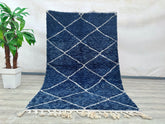The Role of Women in Moroccan Rug Making.
Moroccan Rug Making: A Testament to Cultural History and Women Empowerment
Moroccan rug making is an art form deeply woven into the fabric of Morocco’s rich cultural history, with women playing a pivotal role in its continuation and evolution. This article explores the significant contributions of women weavers, their challenges, and the cultural importance of their work in producing beautiful hand-made rugs.
Women as Custodians of Cultural Heritage
In rural and mountainous regions of Morocco, rug making is primarily a craft driven by women. From a young age, girls are taught the intricate skills of weaving by their mothers and grandmothers, passing down centuries-old techniques from generation to generation. This tradition goes beyond rug production; it serves as a means of cultural transmission and community bonding, making Moroccan women the custodians of a rich cultural heritage.
Techniques and Artistic Expression
Moroccan rugs, including the famous Berber rugs, are not just functional items but also a form of artistic expression. Women weavers often weave personal stories, tribal folklore, and symbolic meanings into their designs. Every knot and color choice holds significance, reflecting the weaver’s experiences, hopes, and dreams.
The weaving techniques used by Moroccan women are as diverse as the rugs themselves. Some of the primary methods include:
-
Knotting: Employed to create plush, pile rugs like those from the Beni Ourain tribes.
-
Flat Weaving: Seen in Kilim rugs, which are lighter and more tapestry-like, showcasing intricate patterns.
Economic Impact
For many Moroccan women, rug making is not just a cultural practice but a critical source of income. In rural areas, where economic opportunities are limited, selling handmade rugs provides essential financial support for their families. This economic significance has also led to the formation of cooperatives, where women collaborate to produce and market their rugs, empowering themselves and gaining more negotiating power in a predominantly male-dominated market.
Challenges and Opportunities
Despite their skills and dedication, women rug makers face significant challenges. Balancing the preservation of traditional techniques while adapting to evolving market demands is a constant struggle. Additionally, receiving fair compensation can be difficult, especially for those working independently rather than through cooperatives.
However, the growing global appreciation for handmade Moroccan rugs has created new opportunities. The rise in ethical consumerism and interest in sustainable, fair-trade products has expanded the market for these artisanal rugs, offering Moroccan women weavers a broader audience and increased potential earnings.
Supporting Women Weavers
By purchasing a Moroccan rug made by women artisans, you not only help preserve traditional crafts but also support the empowerment of women in rural Morocco. Many organizations now collaborate directly with women weavers, ensuring fair trade practices and providing the tools and training they need to succeed in the market.
Conclusion
The role of women in Moroccan rug making is a testament to their strength, creativity, and resilience. These artisans are not merely producing rugs; they are preserving a vibrant cultural heritage and uplifting their communities in meaningful ways. By choosing to buy authentic Moroccan handmade rugs, you contribute to sustaining this valuable art form and supporting the women who are its heart and soul.
Featured Products
169 x 251 cm = 5.5 x 8.2 ft moroccan wool rug, moroccan style rug, bohemian rug, handmade rug, outdoor patio, beniourain Rug, decor rug, Handmade Gift
- $599.00
$1,830.00- $599.00
- (-67%)
- Unit price
- / per
155 x 247 cm = 5.1 x 8.1 ft Diamonds Blue Soft Dots Berber Runner Rug - Handmade Moroccan Wool, Minimalist Design, Vintage Style, Perfect for Weddings & Bohemian Decor
- $599.00
$1,830.00- $599.00
- (-67%)
- Unit price
- / per
- authentic
- Authentic Moroccan rug
- Beni Rugs
- Beniouraincarpets
- Berber rug history
- Berber tribes
- Custom Area Rug
- Custom Moroccan Rugs
- Hand-woven rugs
- Handmade carpet
- Luxury home decor
- Modern Beni rugs
- Moroccan Berber rug
- Moroccan home décor
- Moroccan rug aesthetics
- Moroccan rug authenticity
- Moroccan rug buying guide
- Neutral hue rugs
- Plush area rug
- Rug craftsmanship
- Rug interior alignment
- soft moroccan rug
- Timeless rug designs
- Traditional rug design
- White wool rug
- Wool Rug










